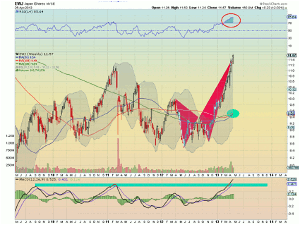The fall of Japanese yen has been accompanied by the rise of the Nikkei Index, and Greg Harmon of Dragonfly Capital points out that warning signs might be appearing in this popular ETF.
Sentiment on the Japanese stock market seems to be very bullish. Analysts left and right are coming out with buy recommendations. Contrarian players would take that sentiment as a signal to sell the market. Generally, I do not recommend taking any kind of action, especially contrarian, based on sentiment alone, but in this case I can see five other reasons that support the case for a sell-off in the near term in the weekly chart below of the Japan iShares ETF (EWJ).
Japan iShares ETF (EWJ)
- The price completed a bearish crab harmonic at 11.39. A move back lower has an Initial price objective of 10.39 on a 38.2% retracement of the pattern.
- The relative strength index (RSI) is technically overbought and getting to be extreme at 85.
- The moving average convergence divergence indicator (MACD) signal line is also in extreme territory, well above the last three peaks.
- Price is 20% away from the simple moving averages (SMA). Using the 50-week SMA, it has led to major corrections the only two other times it has occurred in the last 10 years.
- The SMA are tightly bunched. This can often lead to a big move.
Remember I did say that it is not wise to trade purely off of sentiment, and these indicators I have pointed out also need to be confirmed before any action is taken. An RSI at 85 can still go to 90 or 95, an extreme MACD can get more extreme and price can continue to extend. Wait for the reversal signals but be prepared and watching.
By Greg Harmon of Dragonfly Capital

















